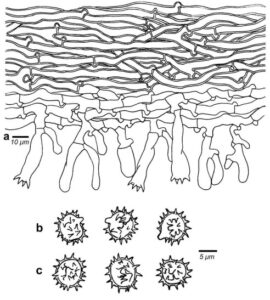Tomentella pallidobrunnea H.S. Yuan, X. Lu & Y.C. Dai, sp. nov.
Index Fungorum number: IF 555767; MycoBank number: MB 555767; Facesofungi number: FoF 05638; Figs. 1, 2, 3
Etymology – Referring to the species having pale brown sterile margin.
Holotype – IFP 019313.
Basidiocarps annual, resupinate, adherent to the substrate, mucedinoid, without odour or taste when fresh, 0.5–1.5 mm thick, continuous. Hymenophoral surface smooth, pale brown to dark brown (6D8–6F7) and concolorous with subiculum when dry. Sterile margin often indeterminate, lighter than hymenophore, byssoid, pale brown (6D8). Rhizomorphs absent. Subicular hyphae monomitic; generative hyphae clamped, thick-walled, frequently branched, 4–7 μm diam, without encrustation, pale brown in KOH, acyanophilous, inamyloid. Subhymenial hyphae clamped, thin-walled, occasionally branched, 5–8 μm diam; hyphal cells short and inflated, pale brown in KOH, acyanophilous, inamyloid. Cystidia absent. Basidia 15–40 μm long and 4–10 μm diam at apex, 3–6 μm at base, with a clamp connection at base, utriform, not stalked, sinuous, without transverse septa, pale brown in KOH and in distilled water,
4-sterigmate; sterigmata 3–6 μm long and 1.5–2.5 μm diam at base. Basidiospores thick-walled, (7–)7.5–8.5(–9)×(6.5– )7–8(–8.5) μm, L=8.03 μm, W=7.37 μm, Q =1.05–1.12 (n = 60/2), globose to subglobose in frontal and lateral views, echinulate, pale brown in KOH and in distilled water, cyanophilous, inamyloid; echinuli usually isolated, sometimes grouped in 2 or more, up to 2 μm long.
Material examined – CHINA, Jilin Province, Changbaishan Nature Reserve, on fallen angiosperm branch, 10 August 2016, Yuan 11493 (IFP 019313, holotype), Yuan 11481 (IFP 019314).
GenBank numbers – ITS: MK211731, MK211730; LSU: MK446402, MK446401.
Notes – Tomentella bryophila resembles T. pallidobrunnea by having basidiocarps adherent to the substrate, the absence of rhizomorphs, clamped hyphae, thick-walled subicular hyphae, thin-walled subhymenial hyphae and echinulate basidiospores of approximately the same shape. But, it differs by having dark blonde to raw umber basidiocarps and thin-walled, bigger basidiospores (7.5–10.5 μm, Kõljalg 1996). T. megaspora is similar to T. pallidobrunnea by having brown to dark brown basidiocarps adherent to the substrate, clamped hyphae, utriform basidia, globose to subglobose basidiospores and the absence of rhizomorphs. However, it differs by its pelliculose basidiocarps and bigger basidiospores (9–11×8–10 μm).

Figure 1 – A basidiocarp of Tomentella pallidobrunnea (IFP 019313, holotype)

Figure 2 – SEM of basidiospores of Tomentella pallidobrunnea (IFP 019313, holotype)

Figure 3 – Microscopic structures of Tomentella pallidobrunnea (IFP 019313, holotype). a Section through a basidiocarp. b Basidiospores in frontal view. c Basidiospores in lateral view
